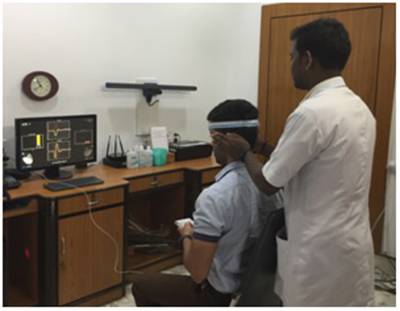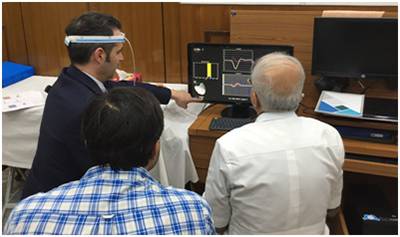functional Head Impulse Test (fHIT)
Our clinic, VERTIGO and DEAFNESS CLINIC has recently acquired the functional Head Impulse Test (fHIT) system which is the newest gadget in vestibulometry and the latest addition to the neurotologist’s diagnostic armamentarium. This new device evaluates the functional status of each of the six semicircular canals in the vestibular labyrinth by ascertaining the efficacy of the rotational vestibulo-ocular reflex (rVOR). There are many tests to evaluate the semicircular canals like the caloric test VNG/ENG, the Dynamic Visual Acuity (DVA) test, Gaze Stabilization Test (GST), the Video Head Impulse Test (VHIT) all of which we use daily in our clinic (vertigoclinic.in), but all these tests have a lot of limitations and are pretty complicated and cumbersome tests requiring high tech, very sophisticated and costly equipment and skilled manpower that very few centers across the world can afford. The USP of fHIT is that this is a functional test and reliably measures the functional status of the semicircular canals (by ascertaining the efficiency of the rVOR) in a quick, very simple, easy to perform way and with a perfectly physiological stimulus. Not only that, it also provides easy to understand information that is clinically relevant to the neurotologist.
 The Functional head impulse test (fHIT) tells us whether the six semicircular canals are functioning perfectly to maintain a stable gaze when there is a fast head movement. The function of the VOR is to keep visual objects in focus and maintain a stable gaze with perfect visual acuity when there is a fast head movement. Visual acuity is the clarity of vision and is dependent on the stability and sharpness of the retinal focus within the eye. Readability or the faculty of recognizing a visual object like a letter/ figure / picture depends on visual acuity. If the images of the visual surroundings are not stable in the retina, there will naturally be a loss of visual acuity. If a semicircular canal is defective, then the rVOR which is generated from that semicircular canal is poor and images of the visual surroundings slip in the retina (loss of gaze stabilization) whenever there is a sudden fast head movement in the plane of that semicircular canal. This causes a loss of the sharpness of the visual focus which in turn leads to a blurring of vision and a loss of visual acuity and consequently a degradation of readability. The functional Head Impulse Test determines whether there is any loss of readability on sudden head movement at different speeds. The fHIT objectively documents the performance of the patient’s VOR in real life practical situation i.e., fast head movement (which we always do in our day to day lives) at different speeds of head rotation and documents at which specific speed range is the VOR deficient and in which specific canal. Testing the vestibular system at different frequencies of vestibular stimulation (i.e. at different speeds of head rotation) is a very important part of modern vestibulometry. For more details on fHIT please visit the blog page of vertigoclinic.in and see the write up on fHIT.
The Functional head impulse test (fHIT) tells us whether the six semicircular canals are functioning perfectly to maintain a stable gaze when there is a fast head movement. The function of the VOR is to keep visual objects in focus and maintain a stable gaze with perfect visual acuity when there is a fast head movement. Visual acuity is the clarity of vision and is dependent on the stability and sharpness of the retinal focus within the eye. Readability or the faculty of recognizing a visual object like a letter/ figure / picture depends on visual acuity. If the images of the visual surroundings are not stable in the retina, there will naturally be a loss of visual acuity. If a semicircular canal is defective, then the rVOR which is generated from that semicircular canal is poor and images of the visual surroundings slip in the retina (loss of gaze stabilization) whenever there is a sudden fast head movement in the plane of that semicircular canal. This causes a loss of the sharpness of the visual focus which in turn leads to a blurring of vision and a loss of visual acuity and consequently a degradation of readability. The functional Head Impulse Test determines whether there is any loss of readability on sudden head movement at different speeds. The fHIT objectively documents the performance of the patient’s VOR in real life practical situation i.e., fast head movement (which we always do in our day to day lives) at different speeds of head rotation and documents at which specific speed range is the VOR deficient and in which specific canal. Testing the vestibular system at different frequencies of vestibular stimulation (i.e. at different speeds of head rotation) is a very important part of modern vestibulometry. For more details on fHIT please visit the blog page of vertigoclinic.in and see the write up on fHIT.
 The fHIT is not at this stage a replacement of the other tests but definitely a very promising addition to the neurotological test battery and a boon to the clinician in many ways because of its simplicity, affordability, portability and very negligible footprint. We have been using the system in our clinic for the last two weeks and it has been a fascinating experience. The engineer Mr Alessandro Florian who had devised the machine had flown down from Italy and was with us at VERTIGO & DEAFNESS CLINIC for a couple of days for clinical evaluation of the fHIT. Three months back Prof. Dr. Marco Mandala from Italy who had pioneered the clinical work on the fHIT had visited us at VERTIGO and DEAFNESS CLINIC. We have picked up quite a few cases of abnormalities by fHIT especially in the high frequency range where the patient had balance problems but all the other tests have shown normal findings. It is hence a very sensitive test.
The fHIT is not at this stage a replacement of the other tests but definitely a very promising addition to the neurotological test battery and a boon to the clinician in many ways because of its simplicity, affordability, portability and very negligible footprint. We have been using the system in our clinic for the last two weeks and it has been a fascinating experience. The engineer Mr Alessandro Florian who had devised the machine had flown down from Italy and was with us at VERTIGO & DEAFNESS CLINIC for a couple of days for clinical evaluation of the fHIT. Three months back Prof. Dr. Marco Mandala from Italy who had pioneered the clinical work on the fHIT had visited us at VERTIGO and DEAFNESS CLINIC. We have picked up quite a few cases of abnormalities by fHIT especially in the high frequency range where the patient had balance problems but all the other tests have shown normal findings. It is hence a very sensitive test.
The best part of the fHIT system is the semicircular canal rehabilitation program (physical therapy) that is packaged with it, whereby the defective semicircular canals as identified by the fHIT, can be stimulated at the specific range of frequencies (i.e., at different accelerations) depending on the range of speeds where the abnormality has been found for a specific semi-circular canal. The software for the rehabilitation program can be loaded into the patient’s smart phone and a small patented magnetometer given to the patient so that the rehab can be carried out by the patient at home also. So this fHIT is not only a diagnostic device but also a therapeutic device where specific targeted physical therapy to stimulate the diseased canal is possible. Gone are the days of tear-away sheets of the non specific exercises that doctors handover to patients. They do more harm than good as the patient invariably does the exercises incorrectly that stimulates the vestibular system in a wrong way. Modern vestibular physiotherapy entails specific organ targeted exercises for specific disorders after modern vestibulometry has very precisely diagnosed the disorder. This is why we have a special vestibular physiotherapy unit with different very sophisticated instruments at VERTIGO and DEAFNESS CLINIC where the exercises are carried out and taught by trained neuro-physiotherapists. The physical therapy part of fHIT is a new addition to the vestibular physiotherapy unit at VERTIGO and DEAFNESS CLINIC.

